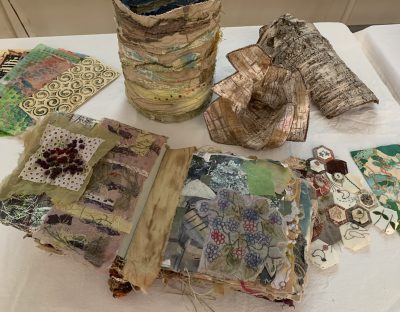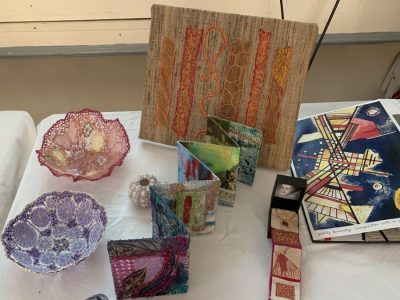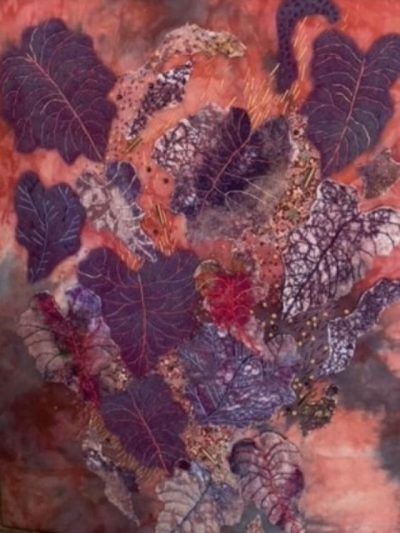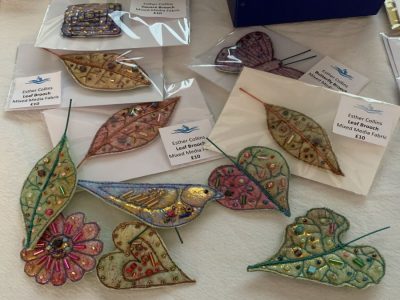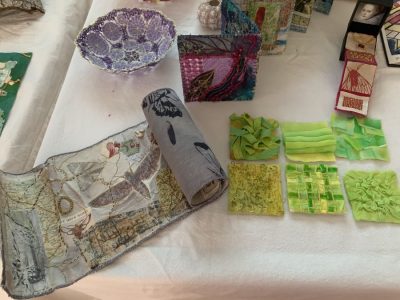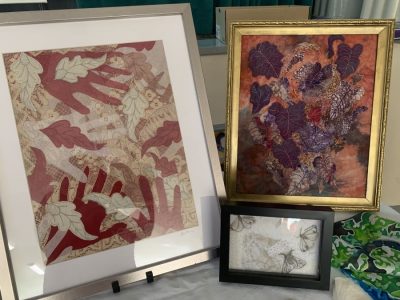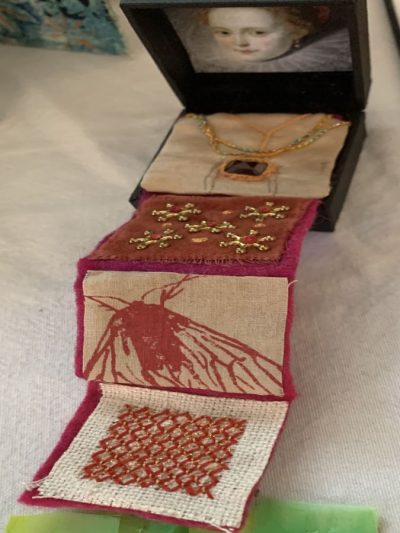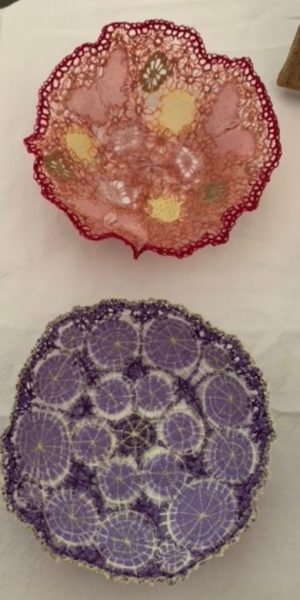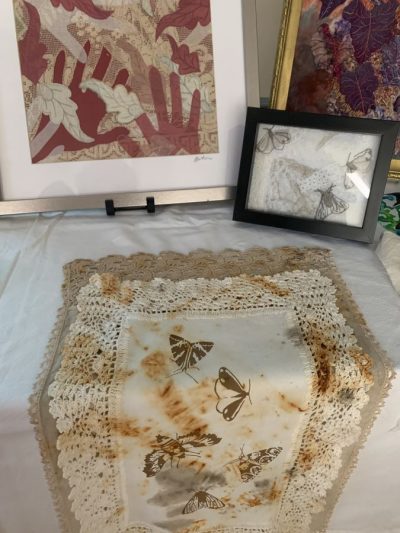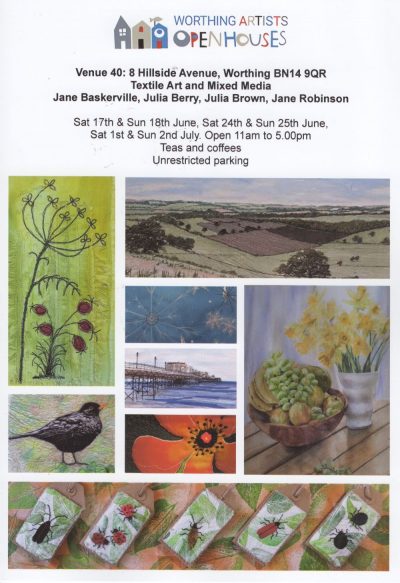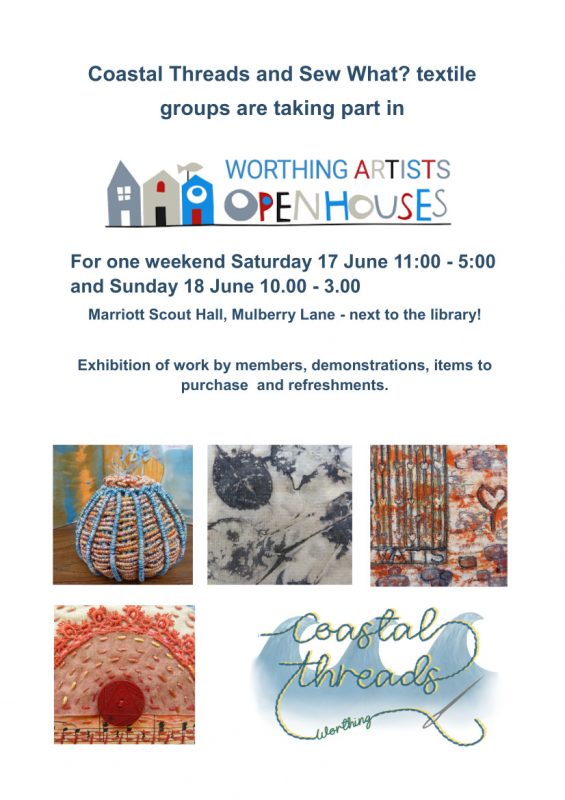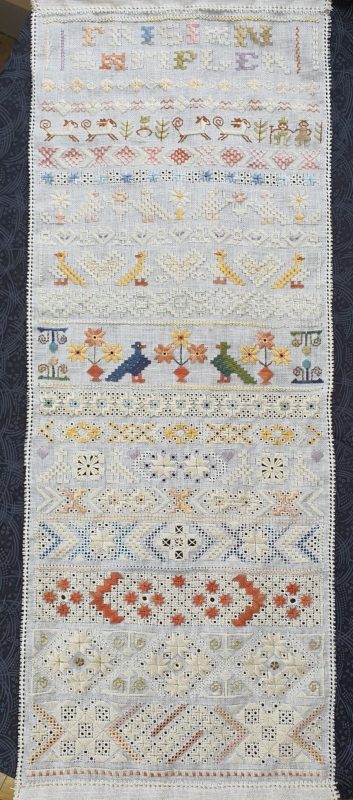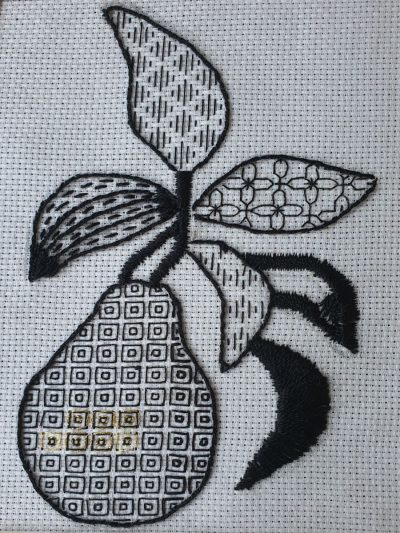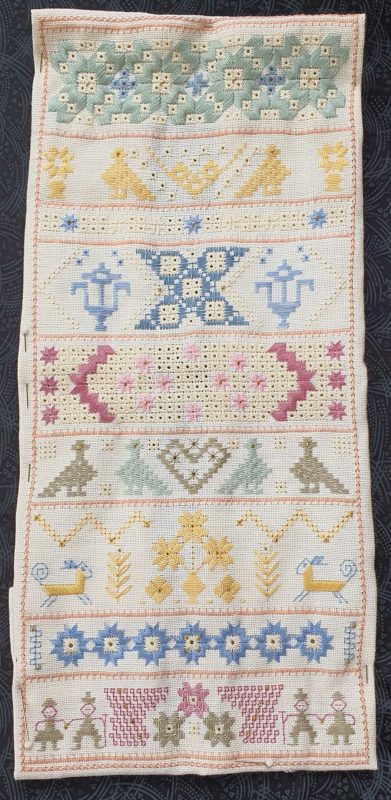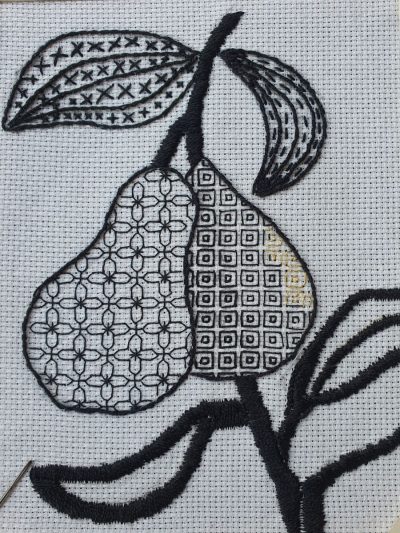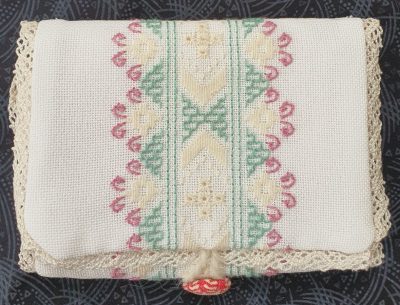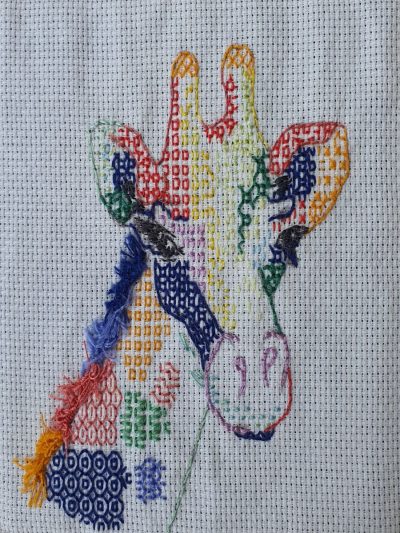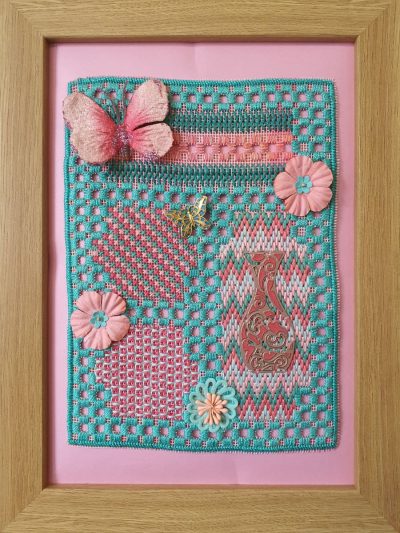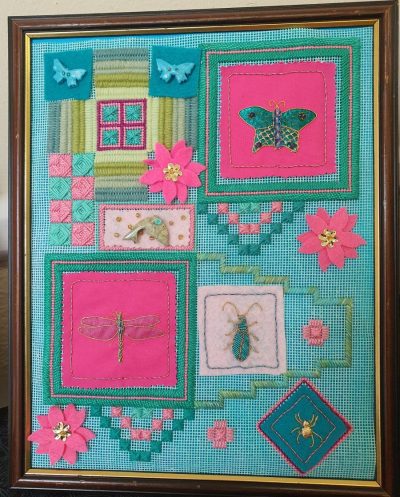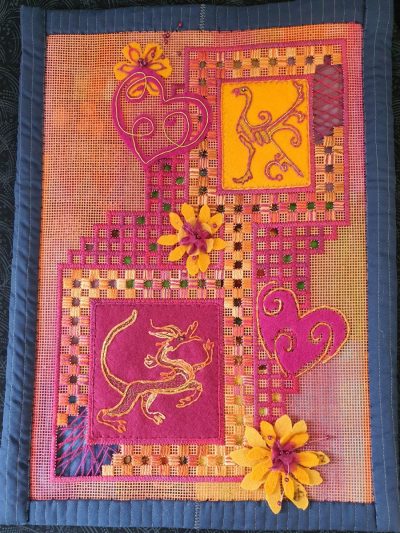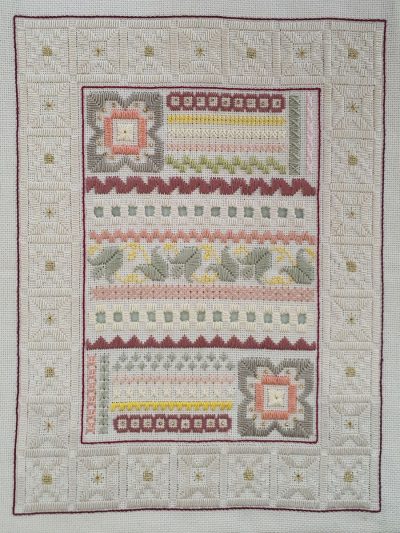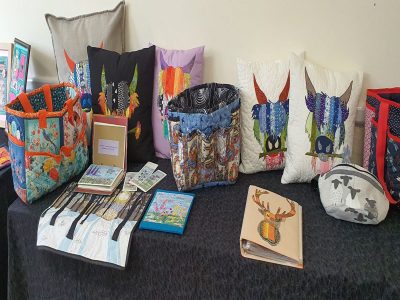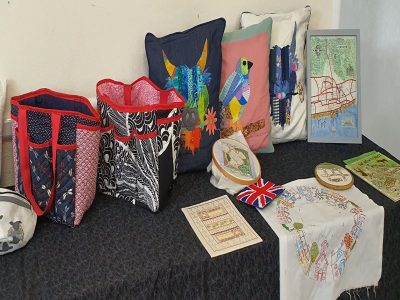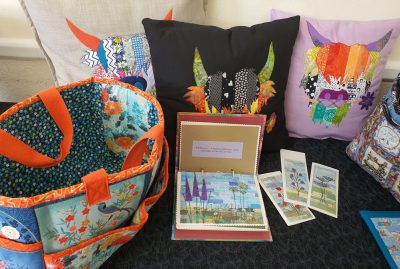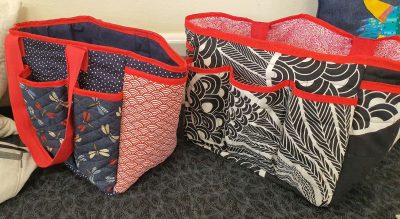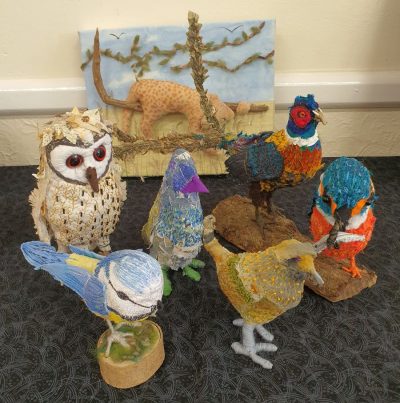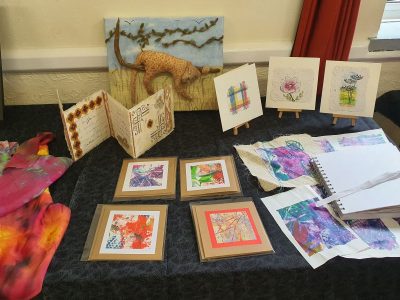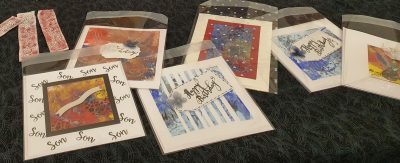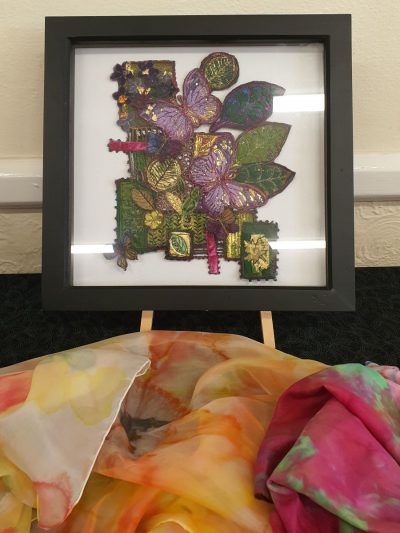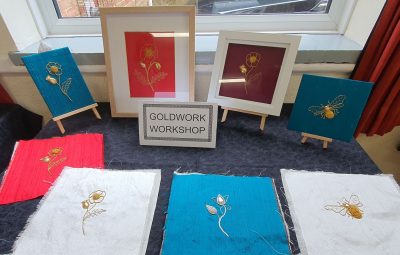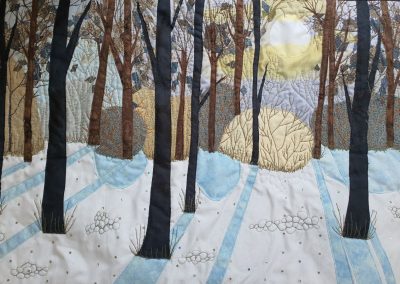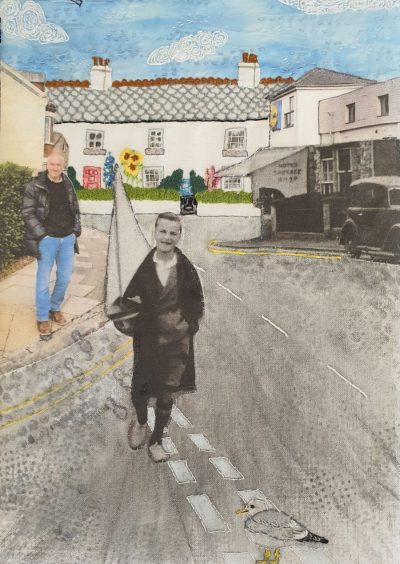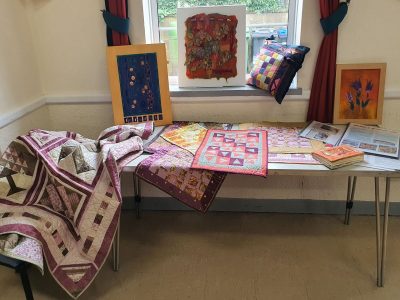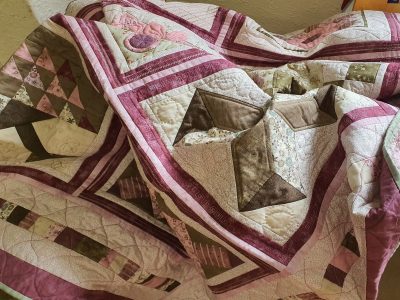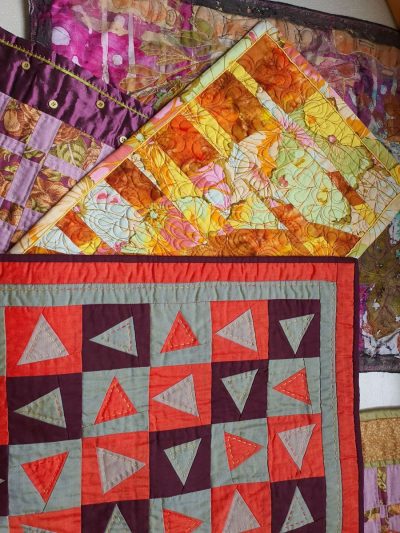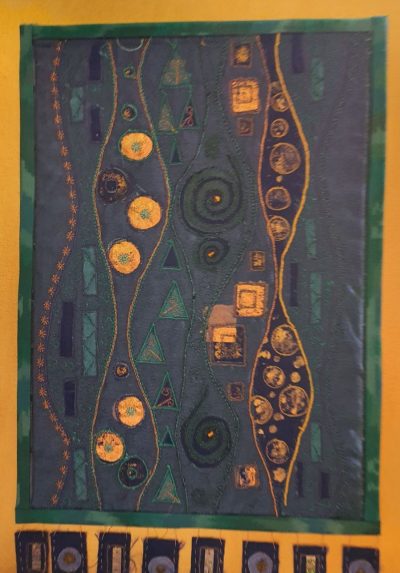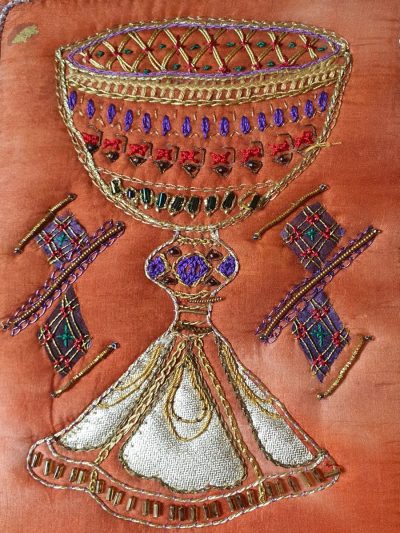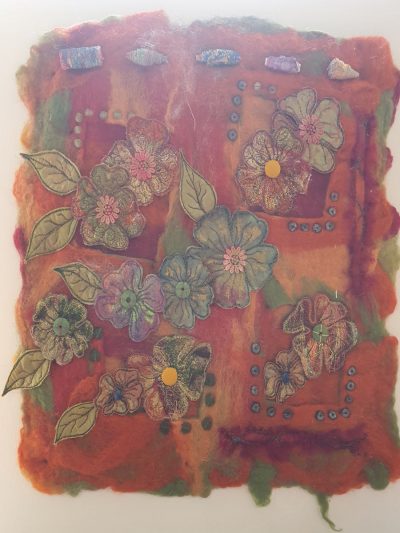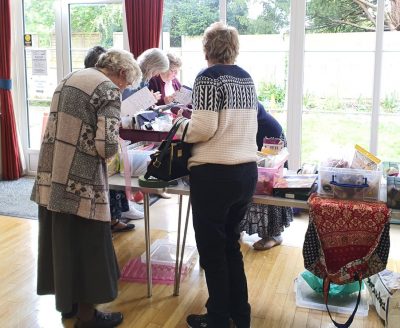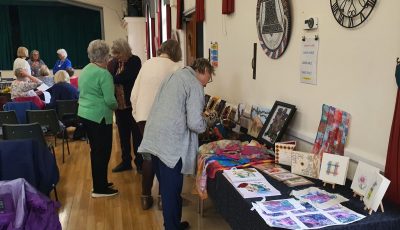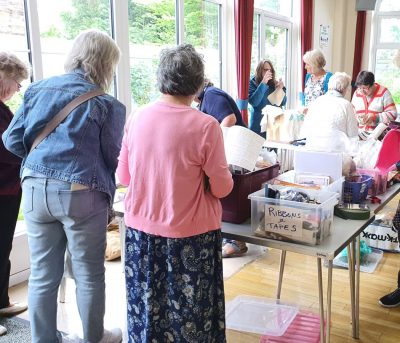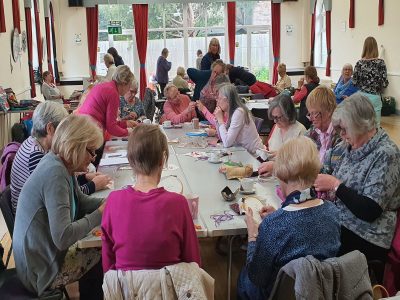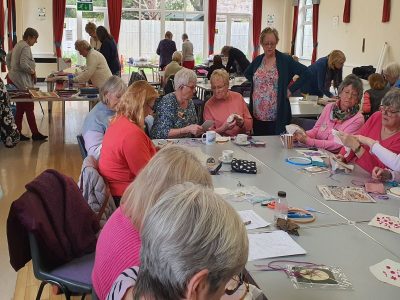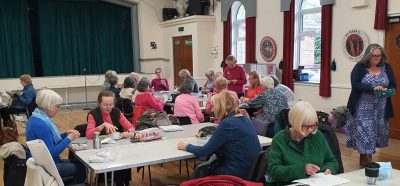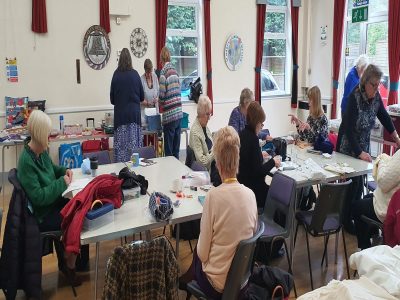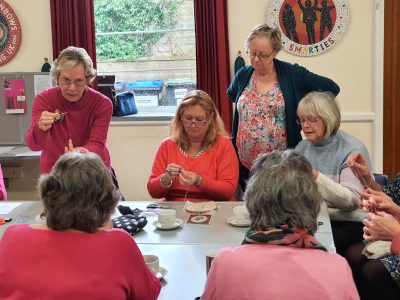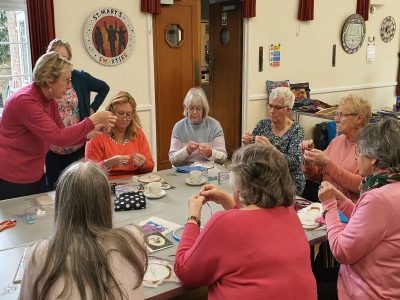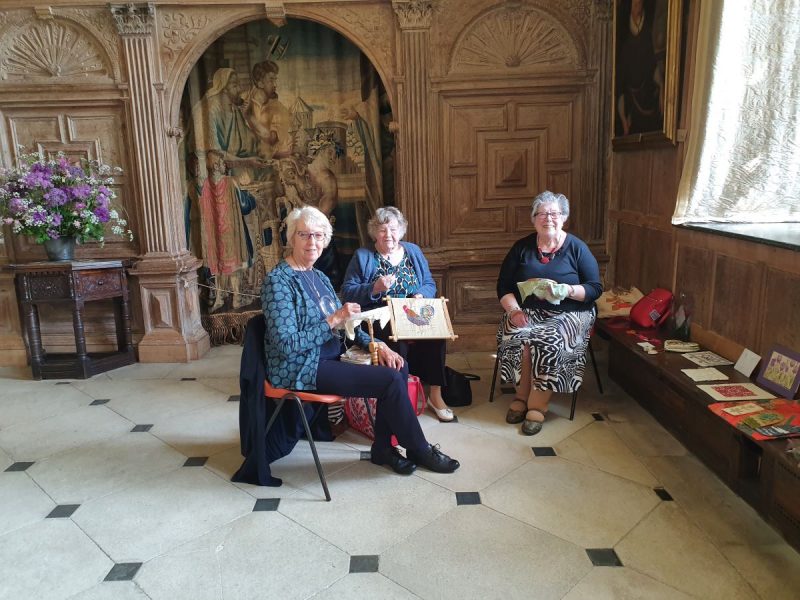 I have added a new ‘page’ on the website, with photos of members stitching at Parham House; look on the main ‘Home’ page and you’ll see the heading there; click on the heading and you will see the photos. You are welcome to add more photos if you have any – just email them to me.
I have added a new ‘page’ on the website, with photos of members stitching at Parham House; look on the main ‘Home’ page and you’ll see the heading there; click on the heading and you will see the photos. You are welcome to add more photos if you have any – just email them to me.
News
Dustbin lids and cabbage leaves…
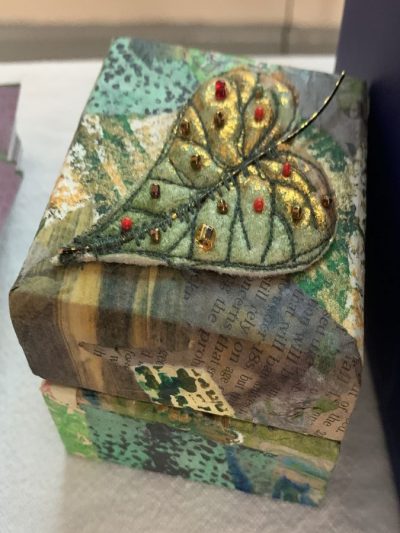 Members enjoyed a fascinating and stimulating talk by textile artist Esther Collins at our June meeting. Esther is a local artist whose work is influenced by her interests in the History of Art, and also by her previous work in graphic design. Design influences include the natural environment, walking in the South Downs and local history.
Members enjoyed a fascinating and stimulating talk by textile artist Esther Collins at our June meeting. Esther is a local artist whose work is influenced by her interests in the History of Art, and also by her previous work in graphic design. Design influences include the natural environment, walking in the South Downs and local history.
I was so disappointed to miss Esther’s talk, and feedback from members has been very enthusiastic. Sadly I can’t add my own reflections on the talk as I usually do, but the talk generated appreciative comments from members, a couple of which I’ll add here: ‘I loved the leaf brooches and was inspired by the use of gold leaf in her decoupage work’ and ‘Esther produces beautiful work combining stitch, textiles and mixed media. I’ve never met any artist that gets inspiration from dustbin lids and cabbage leaves and then goes onto produce stunning pieces of creative work’. I’ll leave you with some images of Esther’s work taken by Maria Griggs and Margaret Borbone (thank you). Esther’s work can speak for itself! If you would like to see more of Esther’s work, and the courses she runs, you can go to her website at https://www.esthercollins.co.uk/
Exhibition of Bojagi work
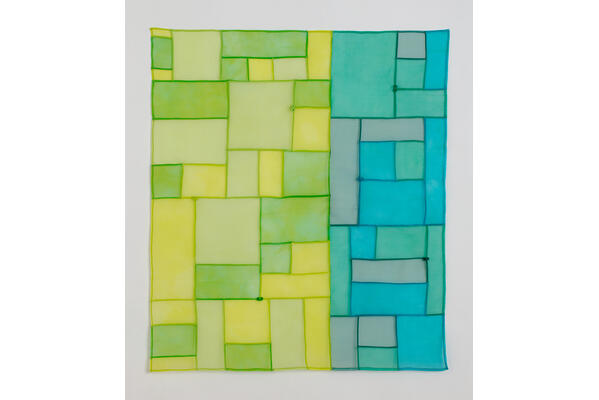 Sara Cook, a local quilter and quilting teacher, has an exhibition of Bojagi work coming up later this month at Colonnade House in Worthing. Bojagi is the art of Korean wrapping-cloths, which Sara makes into pieced and patched colourful wall-hangings which have a translucent quality. It’s from 20th to 25th June, open Tuesday – Sunday (Closed Mondays) 10.00 – 17.00.
Sara Cook, a local quilter and quilting teacher, has an exhibition of Bojagi work coming up later this month at Colonnade House in Worthing. Bojagi is the art of Korean wrapping-cloths, which Sara makes into pieced and patched colourful wall-hangings which have a translucent quality. It’s from 20th to 25th June, open Tuesday – Sunday (Closed Mondays) 10.00 – 17.00.
The exhibition blurb says: ‘Her practice is influenced by the textile traditions of Bojagi, Korean wrapping cloths. The translucent qualities of Bojagi, seem to her a perfect medium to express these fleeting moments. The word Bo means wrapping happiness or fortune and was expressed using colour and symbolism. In her works she tries to achieve, Cheon-ji-in, which translates into sky, earth and the harmony of human coexistence. A traditional Korean value that chimes with the pressing need to find a way to live sustainably’. Well worth a visit. https://colonnadehouse.co.uk/event/sara-cook-light-in-the-landscape/
Worthing Artists Open Houses
A year of stitching – a celebration
 At our AGM this month, we enjoyed pop-up exhibitions by each of the three sub-groups: Traditional, Mixed Media and Thursday Workshop Group. We also saw work from the Introduction to Goldwork course, as well as other work that members have done over the year. Cobi also set up a table of Vivienne Proyer’s work for members to see.
At our AGM this month, we enjoyed pop-up exhibitions by each of the three sub-groups: Traditional, Mixed Media and Thursday Workshop Group. We also saw work from the Introduction to Goldwork course, as well as other work that members have done over the year. Cobi also set up a table of Vivienne Proyer’s work for members to see.
The business of the AGM was conducted swiftly, with a report from Annette as outgoing Chair of the group, and a report by Valerie Robinson, Treasurer and Membership Secretary. Annette stood down from the committee, and the group gave grateful thanks for everything she has done for the group over the last few years. Other members of the committee all remained in post: Pam Reeve (Secretary), Valerie Robinson (Treasurer and Membership Secretary), Maria Griggs (Programme planning), Jane Robinson (Website, FB page and Publicity), Margaret Borbone (Newsletter and Fabric sales). Two new (or rather returning) committee members were elected: Jane Baskerville, and Anne Turner.
Scroll down to see work in the pop-up exhibitions. Let me know if you would like your name added to your work. Click on the photos to enlarge them.
Traditional Group
Thursday Workshop Group
Mixed Media Group
Goldwork Workshop
Other work by members
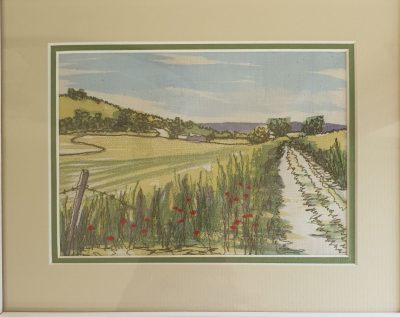
Viviane Proyer’s work
And finally, it was a good chance to have a chat and catch up with other members. All in all, a celebration of a positive and busy year.
Silk ribbon embroidery
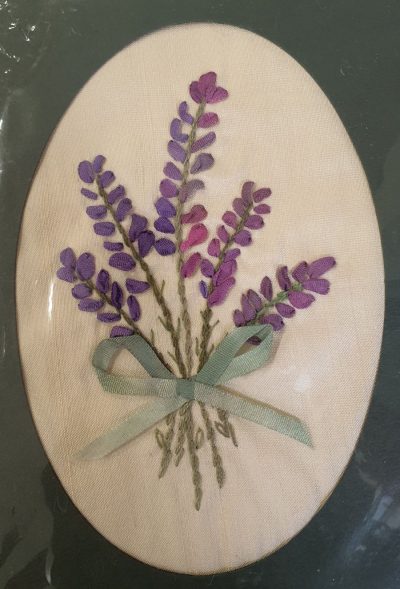 What a lovely afternoon stitching during our April sit-and-sew meeting. Jan Angove demonstrated silk-ribbon shading, and a large group of members joined her for that. Jan had hand-dyed the silk ribbon in advance, so each person’s piece will be unique. This is an example of a finished piece. There was a peaceful buzz of conversation all afternoon. Isn’t it lovely to stitch in company? There are more photos of the afternoon below. Annette reminded members that the AGM is next month, and we would like more people on the committee. It would be fine for a new committee member to join us without taking on a specific role, so that they can find out how things work before deciding if they want to take on more. One of the main things is to have new people with new ideas. The role isn’t too time-consuming; usually one committee meeting per month, and additional roles only if you want them. Don’t be put off if you’re a new member: many of us on the committee were roped in very soon after joining. We would also welcome any long-standing members who might be interested.
What a lovely afternoon stitching during our April sit-and-sew meeting. Jan Angove demonstrated silk-ribbon shading, and a large group of members joined her for that. Jan had hand-dyed the silk ribbon in advance, so each person’s piece will be unique. This is an example of a finished piece. There was a peaceful buzz of conversation all afternoon. Isn’t it lovely to stitch in company? There are more photos of the afternoon below. Annette reminded members that the AGM is next month, and we would like more people on the committee. It would be fine for a new committee member to join us without taking on a specific role, so that they can find out how things work before deciding if they want to take on more. One of the main things is to have new people with new ideas. The role isn’t too time-consuming; usually one committee meeting per month, and additional roles only if you want them. Don’t be put off if you’re a new member: many of us on the committee were roped in very soon after joining. We would also welcome any long-standing members who might be interested.
Viviane’s embroidery
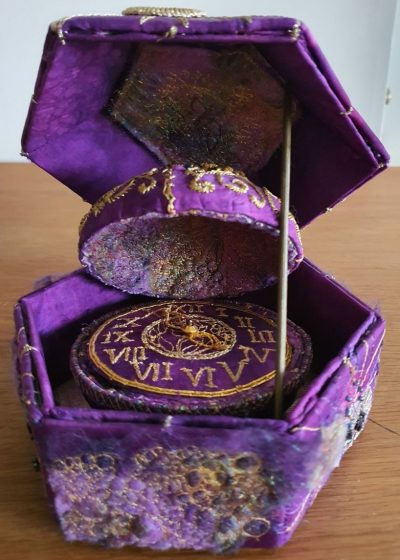 Thanks to Cobi, I have had an opportunity to photograph some of Viviane Proyer’s beautiful work at her home. The photos here give a small taste of her varied talent; her work is a feast for the eyes. The purple and gold piece show here was one of Vivian’s City and Guilds assessed pieces. Look at the detail! If you scroll to the bottom of the images, you will see a photo of the Worthing Town Panel which Viviane masterminded.
Thanks to Cobi, I have had an opportunity to photograph some of Viviane Proyer’s beautiful work at her home. The photos here give a small taste of her varied talent; her work is a feast for the eyes. The purple and gold piece show here was one of Vivian’s City and Guilds assessed pieces. Look at the detail! If you scroll to the bottom of the images, you will see a photo of the Worthing Town Panel which Viviane masterminded. 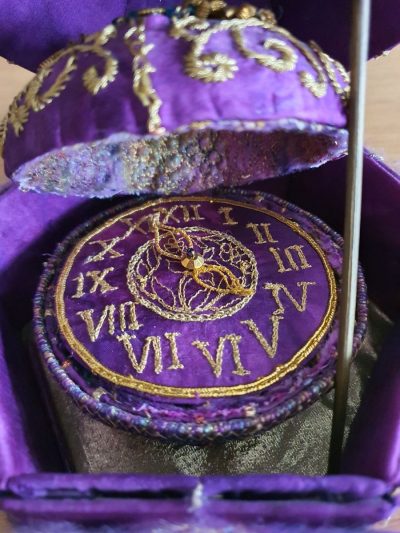
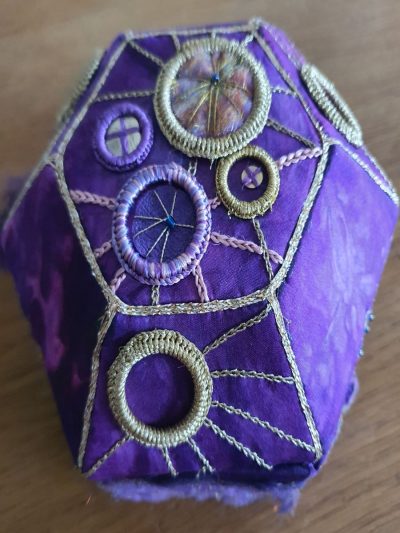
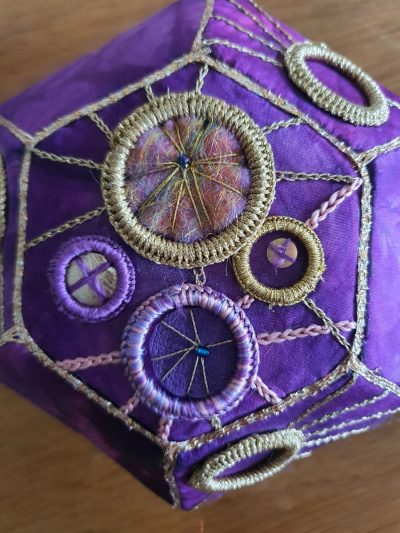
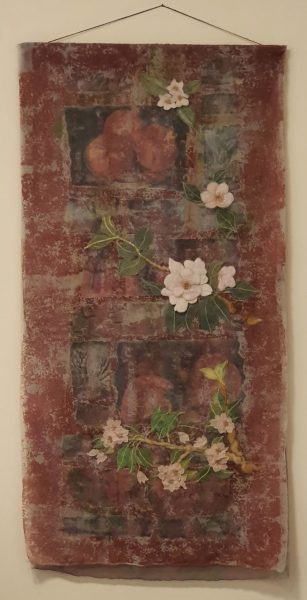
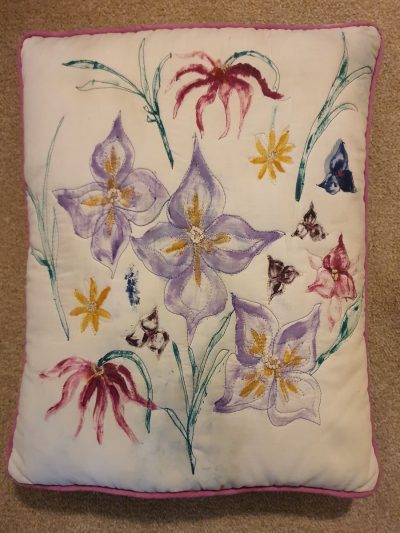
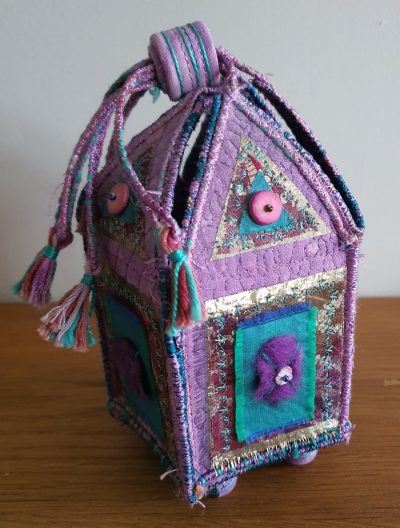
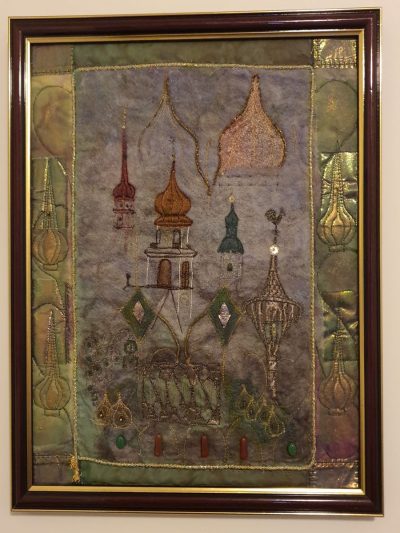
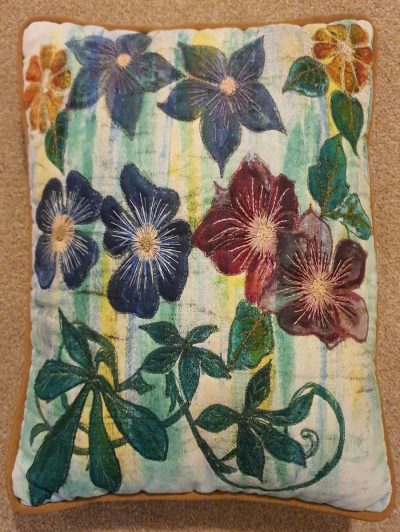 The Worthing Panel (below) can be found in the entrance of Worthing Hospital. Viviane coordinated many detailed contributions from members, which were combined into her design. There is so much detail in the panel that it deserves a whole news post in its’ own right. Photographing it during the day wasn’t very successful due to the lights in the WH Smiths shop oppositive which cast reflections on the glass (which is why it is shown here at a strange angle). I will go back another time after 8m when the shop is closed, when I hope to get some better photographs that show the details. In the meantime, here is a ‘taster’.
The Worthing Panel (below) can be found in the entrance of Worthing Hospital. Viviane coordinated many detailed contributions from members, which were combined into her design. There is so much detail in the panel that it deserves a whole news post in its’ own right. Photographing it during the day wasn’t very successful due to the lights in the WH Smiths shop oppositive which cast reflections on the glass (which is why it is shown here at a strange angle). I will go back another time after 8m when the shop is closed, when I hope to get some better photographs that show the details. In the meantime, here is a ‘taster’.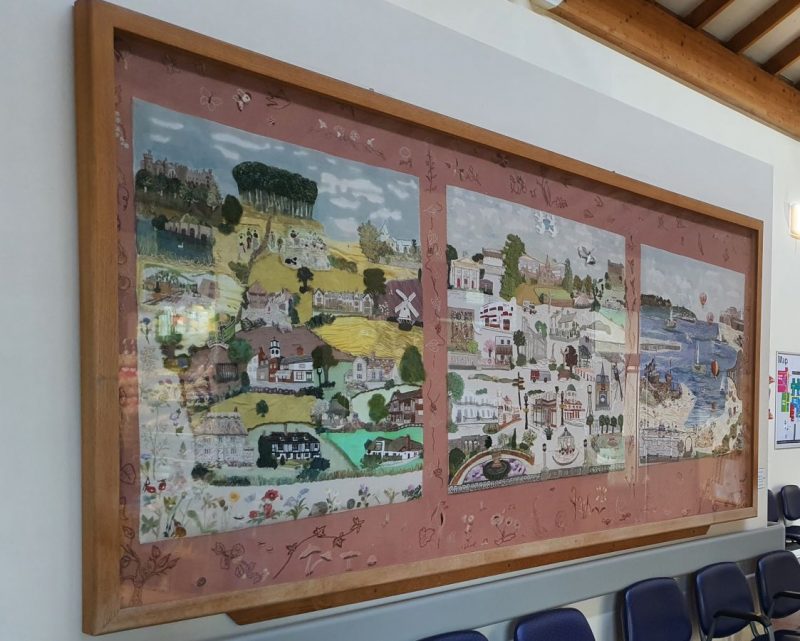
Eileen Amos
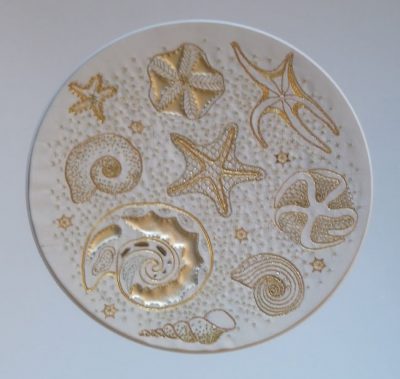 Eileen Amos was a member of our group for many years, and members will have read this tribute to her in our newsletter, written by Jan Angove. Rather than squeeze photos of Eileen’s work into the newsletter, we thought we would put them here on the website so that members can see them at a better resolution, and remind themselves of her talent.
Eileen Amos was a member of our group for many years, and members will have read this tribute to her in our newsletter, written by Jan Angove. Rather than squeeze photos of Eileen’s work into the newsletter, we thought we would put them here on the website so that members can see them at a better resolution, and remind themselves of her talent.
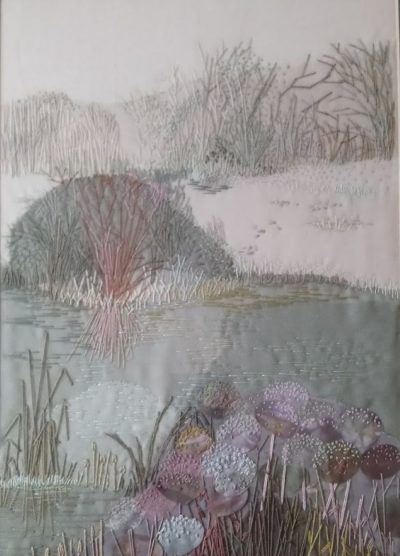 Jan wrote: I met Eileen in 1985. She ran a group “Dressmaking for the Blind” at Northbrook College. She needed an extra pair of hands so I volunteered. As our ladies had limited sight our task was to think of ways to make paper dress patterns usable by highlighting notches with textured stick on dots, checking the layout before the fabric was cut, and threading machine and hand sewing needles, as well as undoing the occasional seam! I learnt a lot about how to fit clothes from Eileen, she was a superb dressmaker. The group ran for many years and was fun as well as providing a meeting place for ladies who shared a love of sewing. The finished garments were worn with such pride.
Jan wrote: I met Eileen in 1985. She ran a group “Dressmaking for the Blind” at Northbrook College. She needed an extra pair of hands so I volunteered. As our ladies had limited sight our task was to think of ways to make paper dress patterns usable by highlighting notches with textured stick on dots, checking the layout before the fabric was cut, and threading machine and hand sewing needles, as well as undoing the occasional seam! I learnt a lot about how to fit clothes from Eileen, she was a superb dressmaker. The group ran for many years and was fun as well as providing a meeting place for ladies who shared a love of sewing. The finished garments were worn with such pride.
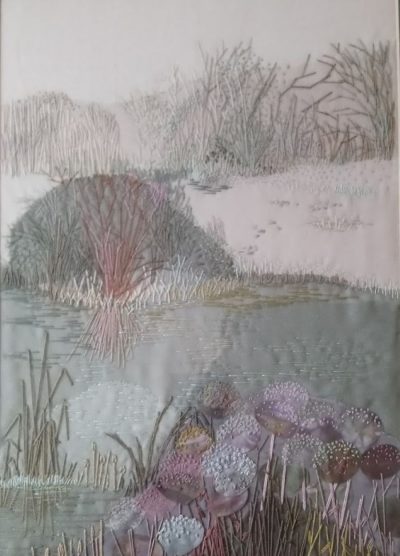 Eileen trained at Brighton College of Art, and then taught dressmaking at Tunbridge Wells College of Art before the family moved to Rustington.
Eileen trained at Brighton College of Art, and then taught dressmaking at Tunbridge Wells College of Art before the family moved to Rustington.
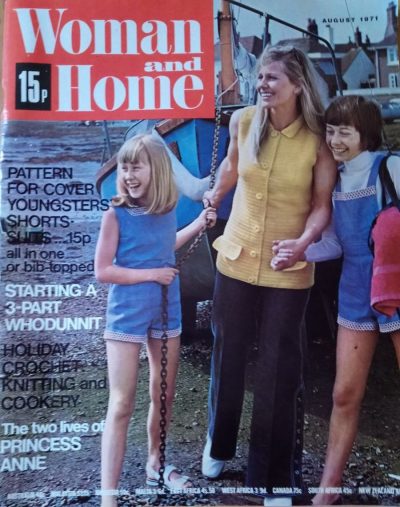 She made some of the examples of sewing techniques for books on dressmaking produced by Ann Ladbury in conjunction with her TV series in the 70’s. Sarah, Eileen’s daughter says she and her sister Karen modelled some of the children’s clothes Eileen made for Woman and Home magazine. There were many clients for whom Eileen would make beautiful clothes. She also made garments for the weaver Geraldine St Aubyn Hubbard, a textile artist based near Chichester. The cloth (silk, cashmere and wool) was woven, then passed to Eileen who made it into loose fitting couture garments destined for London boutiques. This partnership lasted many years.
She made some of the examples of sewing techniques for books on dressmaking produced by Ann Ladbury in conjunction with her TV series in the 70’s. Sarah, Eileen’s daughter says she and her sister Karen modelled some of the children’s clothes Eileen made for Woman and Home magazine. There were many clients for whom Eileen would make beautiful clothes. She also made garments for the weaver Geraldine St Aubyn Hubbard, a textile artist based near Chichester. The cloth (silk, cashmere and wool) was woven, then passed to Eileen who made it into loose fitting couture garments destined for London boutiques. This partnership lasted many years.
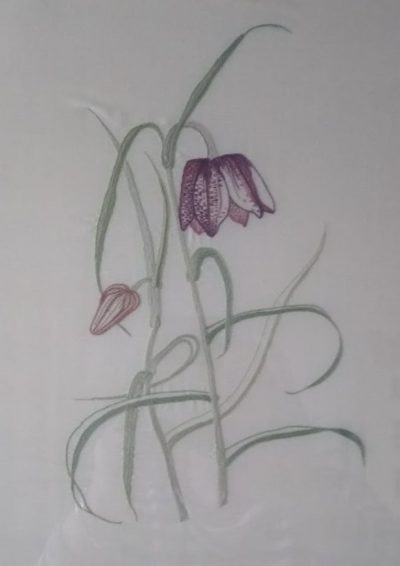 After Eileen gave up some of her dressmaking she turned to hand and machine embroidery on silk which she had painted, producing exquisite pictures and bags. She was a member of the Embroiderer’s Guild for many years, and of Pizazz and exhibited with them. Eventually mobility issues meant she had to give up attending meetings.
After Eileen gave up some of her dressmaking she turned to hand and machine embroidery on silk which she had painted, producing exquisite pictures and bags. She was a member of the Embroiderer’s Guild for many years, and of Pizazz and exhibited with them. Eventually mobility issues meant she had to give up attending meetings.
Over the years I kept in touch with Eileen and we would meet occasionally for coffee and a chat about all things “sewing”.
Jan Angove

